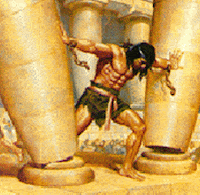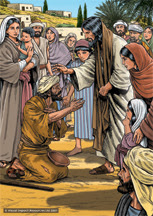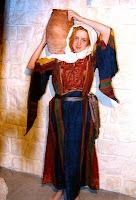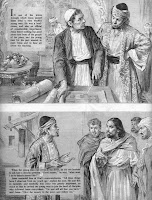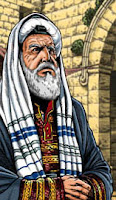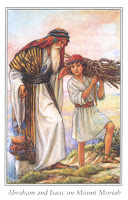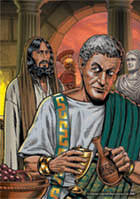
How well do you know the Christmas story? I thought I knew it pretty well, until I started research for our latest set of Bible pictures based on the Nativity story. I've illustrated the Nativity at least three times before, so I wasn't expecting to find anything new in it. (sound familiar?)
For some reason, I hadn't noticed before that the accounts of the Nativity given in Matthew and Luke don't quite match up. Matthew says that Mary, Joseph and baby fled south to Egypt following the birth of Jesus, (Matt 2:13), while Luke says they went north to Nazareth! (Lk 2:39). Whenever you come across what appears to be a contradiction in the Bible, you've usually discovered something that, not only isn't a contradiction, but actually ties up a lot of those loose ends that once puzzled you. At least that's been my experience, and as we will see, this case is no exception!
Luke clearly gives us the details of the first few weeks in the life of the Lord Jesus. The events of the Nativity as recorded by Luke in chapter 2 are as follows:
1). Jesus born in the stable at Bethlehem.
2). Angel appears to shepherds.
3). Shepherds visit baby Jesus in the stable, "after searching". (Amplified Bible).
4). Eight days later, Jesus is circumcised.
5). 32 days later, the family travel the 5 miles to Jerusalem for the Dedication of Jesus. According to
Lev: 12, 40 days are needed for the purification of the mother following the birth of a male child.
This includes the 8 days leading up to the circumcision. (8+32=40).
6). Dedication of Jesus at Jerusalem.
7). The family travels to Nazareth. This is a journey of 65 miles. (approximately 6 days, allowing for the difficult terrain, heat etc).
So roughly 46 days or so after the birth of Jesus, the family are back at home in Nazareth.
But, didn't the wise men visit the baby Jesus in the stable at Bethlehem? It would appear not, Matthew 2:11 clearly says
"And when they had come into the house..." (not a stable). But, wasn't the house in Bethlehem? Before we try to answer that, let's take another look at the events of the Nativity as recorded this time by Matthew in chapter two.
Firstly, we don't read that the wise men followed the star all the way from the east. It seems that the star that initially appeared to the Magi in the East, didn't reappear again until the wise men left Herod's palace, (possibly up to two years later). This would explain their great joy and surprise at seeing the star in v9. The question is, why did the star appear again? The wise men were already on their way to Bethlehem, and when they got there, all they had to do was ask! The shepherds had already told everyone in Bethlehem what had happened in that now famous stable, (Lk 2:17).
Or, did the star appear because the baby Jesus was no longer in the stable, in fact, no longer in Bethlehem? Was the star now guiding them to Nazareth? Notice also that the wise men in v7 presumably told King Herod that the star first appeared two years earlier! This was the reason Herod ordered the slaughter of 14,000 male infants up to two years old.
If the star appeared at the time of the birth, according to experts it would have taken the Magi nine months to travel from Persia to Judea. Add to that the time it must have taken to interpret the meaning of the star from their ancient writings, and the time to gather the supplies and make arrangements for such an epic journey, and two years starts to sound about right!
There is another reason also why it's doubtful that the Magi arrived at the time of the actual birth:
The news of any male babies being brought into the Temple in Jerusalem for dedication, following the visit of the wise men would have aroused so much attention, Herod was sure to have been informed. Especially babies that had been born in Bethlehem! Remember that Herod was in the process of funding the building of a beautiful new Temple for the nation of Israel at this time. The chief priests and scribes had already showed themselves to be more than happy to lead Herod to the Messiah, so that he could worship Him also, (v8). The dedication of Jesus as recorded by Luke must have happened earlier for this reason alone!

There are two problems with this scenario though. Firstly, why would Joseph and his family flee from Nazareth, (which is 65 miles away), following the warning given by the angel? Well, Galilee was still in the northern part of Herod's kingdom, so Herod did have the authority to slay children there also. Could it also be possible that the chief priests and scribes made the same Messianic connection that Matthew made with Nazareth in Matt 2:23? Whatever your view is of that verse, the fact is that Matthew chose to record his interpretation in scripture, so it is possible that others came to the same conclusion regarding it. This would have been reason enough for Herod to send his soldiers north to Nazareth.
But, there's still another problem. The other question that arises is, why they would flee south to Egypt from Nazareth? A journey of over 100 miles that would take them dangerously close to Jerusalem! They would have probably taken the trade route which followed the coast, but it still went through Judea.
There is another scenario however, that does tick all the boxes.
Luke 2:41 records for us the fact that Joseph and his family returned from Nazareth to Jerusalem every year to celebrate the Feast of the Passover. Luke chooses to mention this because, on this occasion, Mary & Joseph lose the twelve year old Jesus! What Luke doesn't record though is the fact that, according to Jewish law, Joseph was required to return to Jerusalem not once, but three times a year, because there were three pilgrim festivals that required the male member of the family to bring his tithes and offerings to Jerusalem. Passover
(Pesach), Pentecost
(Shavuot), and the Feast of Booths
(Sukkot).The population of Jerusalem at these festival times swelled from around 600,000 to 2-3 million! which made accommodation hard to find. It makes sense that Joseph and his family would return to Bethlehem each time, as It is very likely that following the 'press release' given out by the shepherds, following their heavenly visitation, there would have been numerous offers of accommodation in Bethlehem for this special family. So, there would have been up to six visits made by the family to Bethlehem during the two years following the birth of Jesus. It's possible that the family made good friends in Bethlehem and stayed in the same house on each visit.
Was it during one of these visits to Bethlehem that the Magi came bearing gifts? This would explain why they came to see a 'young child' in a 'house', (Matt 2:11), opposed to a 'Babe' in a 'manger', (Luke 2:16). It also makes more sense that Joseph and family fled south to Egypt from Bethlehem which already lies south of Jerusalem. The star would almost certainly be needed too, to guide the Magi to the house where they were lodging.
Conclusion:
So, how should all the details mentioned above effect how Bible artists illustrate the Nativity story? Well, there are a number of points worth taking note of;
1). The wise men didn't visit the stable. Matt 2:11. (This is correctly shown in one of the paintings by Bible artist William Hole).
2). The star didn't appear over the stable. Which makes just about every Christmas card ever made incorrect!
3). The wise men probably didn't follow the star from the East, despite what the carols say!
4). The shepherds were not directed to the stable by a star.
5). There were probably up to 1,000 Persian soldiers accompanying the Magi, as well as those carrying supplies. This was a huge caravan of travelers, correctly shown above by Bible artist James McConnell. (© Look & Learn.com 2007). Incidentally, if you are interested in purchasing this original piece of Bible art by James McConnell shown above, you can!
click here for details.
Those who produce sequential Bible art, (cartoon strip), are less likely to make mistakes like those mentioned above because they move frame by frame through the story, although I did notice, in Paolo Eleuteri-Serpieri's masterpiece on the Nativity, that he shows Joseph and his family returning from Jerusalem to the stable in Bethlehem! This is more likely the mistake of the writer Etienne Dahler though.
As always, I look forward to your thoughts on the above subject. I hope you enjoyed reading this 'Christmas conundrum'!
Update 4 December 2010: One person left an interesting link in the comments which suggests that the birth took place, not in a stable, but in the lower level of a two story house. There was still a manger there as the animals were kept on the ground floor. Have a read at: http://www.answersingenesis.org/articles/2010/11/30/born-in-a-barn
Related posts:
Pictures of the Nativity
Drawing Angels!







